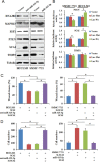MiR-425-5p promotes invasion and metastasis of hepatocellular carcinoma cells through SCAI-mediated dysregulation of multiple signaling pathways
- PMID: 28423650
- PMCID: PMC5458244
- DOI: 10.18632/oncotarget.15958
MiR-425-5p promotes invasion and metastasis of hepatocellular carcinoma cells through SCAI-mediated dysregulation of multiple signaling pathways
Abstract
MicroRNAs (miRNAs) play critical roles in hepatocellular carcinoma (HCC) progression and are key determinants of prognosis. In this study, we found that miR-425-5p was elevated in HCC and correlated with poor prognostic clinicopathological features and low post-operative long-term survival. Multivariate survival analysis indicated that miR-425-5p expression was an independent risk factor for overall and disease-free survival. Interestingly, miR-425-5p promoted invasion and metastasis by HCC cells, but not HCC cell proliferation or apoptosis in vitro. SCAI and PTEN were determined to be downstream targets of miR-425-5p. miR-425-5p-mediated effects were inhibited by ectopic expression of SCAI, and PTEN exhibited a smaller inhibitory effect. SCAI also suppressed PTEN expression. In addition, miR-425-5p promoted epithelial-to-mesenchymal transition (EMT), which was antagonized by SCAI. miR-425-5p also promoted HCC cell invasion and metastasis via SCAI-mediated dysregulation of integrin β1-Fak/Src-RhoA/CDC42, PTEN-AKT, and TIMP2-MMP2/MMP9 signaling. Finally, miR-425-5p promoted metastasis in a xenograft mouse model of HCC. These results indicate that miR-425-5p facilitates EMT and extracellular matrix degradation and promotes HCC metastasis through SCAI-mediated dysregulation of multiple signaling pathways. MiR-425-5p is therefore a potential prognostic biomarker and novel therapeutic target in HCC.
Keywords: PTEN; SCAI; hepatocellular carcinoma; integrin β1; miR-425-5p.
Conflict of interest statement
The authors declare that there are no conflicts of interest.
Figures









Similar articles
-
MicroRNA-130b promotes proliferation and EMT-induced metastasis via PTEN/p-AKT/HIF-1α signaling.Tumour Biol. 2016 Aug;37(8):10609-19. doi: 10.1007/s13277-016-4919-z. Epub 2016 Feb 10. Tumour Biol. 2016. PMID: 26861561
-
MicroRNA-424-5p acts as a potential biomarker and inhibits proliferation and invasion in hepatocellular carcinoma by targeting TRIM29.Life Sci. 2019 May 1;224:1-11. doi: 10.1016/j.lfs.2019.03.028. Epub 2019 Mar 12. Life Sci. 2019. PMID: 30876939
-
miR-139-5p inhibits epithelial-mesenchymal transition, migration and invasion of hepatocellular carcinoma cells by targeting ZEB1 and ZEB2.Biochem Biophys Res Commun. 2015 Jul 31;463(3):315-21. doi: 10.1016/j.bbrc.2015.05.062. Epub 2015 May 27. Biochem Biophys Res Commun. 2015. PMID: 26022123
-
MicroRNAs Involved in Metastasis of Hepatocellular Carcinoma: Target Candidates, Functionality and Efficacy in Animal Models and Prognostic Relevance.Cancer Genomics Proteomics. 2020 Jan-Feb;17(1):1-21. doi: 10.21873/cgp.20163. Cancer Genomics Proteomics. 2020. PMID: 31882547 Free PMC article. Review.
-
MicroRNA as Key Players in Hepatocellular Carcinoma: Insights into Their Role in Metastasis.Biochem Genet. 2025 Apr;63(2):1014-1062. doi: 10.1007/s10528-024-10897-0. Epub 2024 Aug 5. Biochem Genet. 2025. PMID: 39103713 Review.
Cited by
-
miR-425-5p improves inflammation and septic liver damage through negatively regulating the RIP1-mediated necroptosis.Inflamm Res. 2020 Mar;69(3):299-308. doi: 10.1007/s00011-020-01321-5. Epub 2020 Jan 30. Inflamm Res. 2020. PMID: 32002587
-
Long noncoding RNAs HAND2-AS1 ultrasound microbubbles suppress hepatocellular carcinoma progression by regulating the miR-873-5p/tissue inhibitor of matrix metalloproteinase-2 axis.World J Gastrointest Oncol. 2024 Apr 15;16(4):1547-1563. doi: 10.4251/wjgo.v16.i4.1547. World J Gastrointest Oncol. 2024. PMID: 38660652 Free PMC article.
-
ZNF197-AS1/miR-425/GABARAPL1 axis: a novel regulatory mechanism in uveal melanoma.Am J Physiol Cell Physiol. 2024 Dec 1;327(6):C1638-C1650. doi: 10.1152/ajpcell.00457.2024. Epub 2024 Sep 23. Am J Physiol Cell Physiol. 2024. PMID: 39308299 Free PMC article.
-
miR-425-5p, a SOX2 target, regulates the expression of FOXJ3 and RAB31 and promotes the survival of GSCs.Arch Clin Biomed Res. 2020;4(3):221-238. doi: 10.26502/acbr.50170100. Epub 2020 Jun 18. Arch Clin Biomed Res. 2020. PMID: 32905473 Free PMC article.
-
Overexpression of MALAT1 Relates to Lung Injury through Sponging miR-425 and Promoting Cell Apoptosis during ARDS.Can Respir J. 2019 Dec 1;2019:1871394. doi: 10.1155/2019/1871394. eCollection 2019. Can Respir J. 2019. PMID: 31871512 Free PMC article.
References
-
- Torre LA, Bray F, Siegel RL, Ferlay J, Lortet-Tieulent J, Jemal A. Global cancer statistics, 2012. CA Cancer J Clin. 2015;65:87–108. - PubMed
-
- Fan ST, Mau Lo C, Poon RT, Yeung C, Leung Liu C, Yuen WK, Ming Lam C, Ng KK, Ching Chan S. Continuous improvement of survival outcomes of resection of hepatocellular carcinoma: a 20-year experience. Ann Surg. 2011;253:745–58. - PubMed
-
- Llovet JM, Bruix J. Novel advancements in the management of hepatocellular carcinoma in 2008. J Hepatol. 2008;48:S20–37. - PubMed
-
- Aravalli RN, Steer CJ, Cressman EN. Molecular mechanisms of hepatocellular carcinoma. Hepatology. 2008;48:2047–63. - PubMed
-
- Chen CZ. MicroRNAs as oncogenes and tumor suppressors. N Engl J Med. 2005;353:1768–71. - PubMed
MeSH terms
Substances
LinkOut - more resources
Full Text Sources
Other Literature Sources
Medical
Research Materials
Miscellaneous

